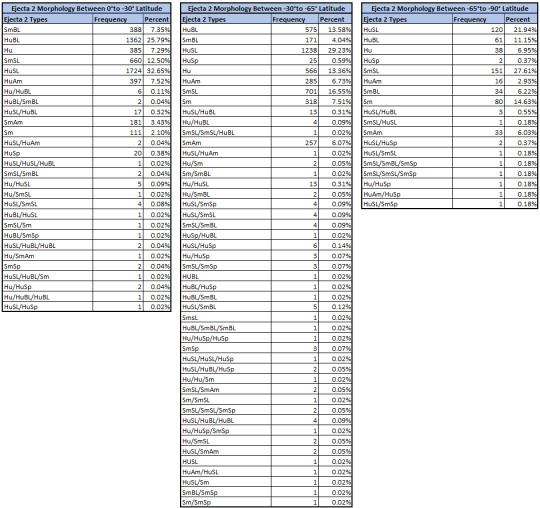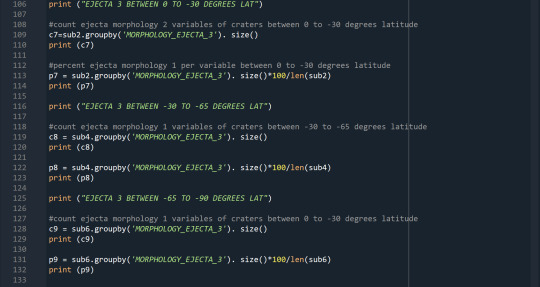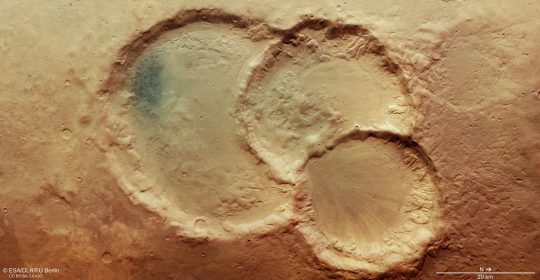The search of a young geologist in understanding associations between Mars impact crater latitudes and dominant ejecta morphologies
Don't wanna be here? Send us removal request.
Text
For this phase, I decided to consider the number of layers of the Mars crater ejecta, aside from the morphology type, per latitude zone. Shown below is the univariate graph of the number of craters per latitude zone:


The graph is unimodal and seems to be skewed to the right, having greater values at the lower latitude zones. Next is the univariate graph of the ejecta 1 morphology type per latitude zone:


The graph is also unimodal with the morphology type called Rd as the dominant type between the Mars equator and 30 degrees South. Shown below is the univariate graph of the number of layers of the Mars craters between 0 to 30 degrees south:


The graph is also unimodal, having a peak at no layers (0) and right-skewed with higher values at the lower number of layers. Lastly, shown below is the bivariate graph of the number of layers of the Mars crater ejecta per latitude zones (0-10°S, 10-20°S, 20-30°S):



We can see that within all latitude zones, the craters have a dominant crater ejecta morphology with no layers followed by 1 layer only.
0 notes
Text











Since the study aims to determine if there is a dominant Mars crater ejecta morphology per latitude zone (0°-30°S, 30°-65°S, and 65°-90°S) on the southern hemisphere where the crust is older, only the missing values were coded out. The unique classifications were retained and not binned together even though there are a lot of ejecta types to ensure that the unique crater ejecta morphologies are presented. For ejecta 1 morphology, Rd type is dominant in all latitude zones. For ejecta morphology 2 (the morphology of the layers themselves), the dominant morphologies are HuBL type between the equator to 30°S, HuSL type between 30°-65°S, and SmSL type for 65°-90°S. Lastly, the dominant ejecta morphology 3 (generally unique morphology) are Small-crown between 0°-30°S, Pin-cushion between 30°-65°S, and Outer is Splash between 65°-90°S.
0 notes
Text







From the new global database of Mars craters with diameters ≥ 1km, ejecta morphologies of impact craters were observed: "Is there a dominant impact crater ejecta morphology per latitude zone?". With this, craters in the southern hemisphere were grouped per latitude zone (0°-30°S, 30°-65°S, and 65°-90°S). Based on previous studies, the southern hemisphere has an older crust, showcasing more craters than the northern hemisphere, hence the choice for this study (McCauley, 2002). The division of the latitude zones was also based on the classification of quadrangles established by the US Geological Survey (Schaber, 2005). For each zone, the dominant ejecta morphology was observed. From the 133,588 craters between the equator to 30°S, 6.23% of the craters are classified with Rd type of ejecta morphology after an 88.36% which exhibit no ejecta morphology. For the 86,145 craters between 30°-65°, 0.57% exhibit SLERS ejecta morphology after an 87.62% with an unidentified or no ejecta morphology. Lastly, from the 13,679 craters between 65°-90°S, the dominant ejecta morphology is the Rd type after an 88.36% of no ejecta morphology. Excluding those with no ejecta morphology, this shows that 0°-30°S and 65°-90°S has the same dominant ejecta morphology.
The dominant morphology of the layers themselves (ejecta morphology 2) per latitude zone has also been observed. For 0°-30°S and 30°-65°S, the dominant morphology is HuSL while for latitudes 65°-90°S, the dominant morphology is SmSL.
Dominant generally unique morphology was also noted (ejecta morphology 3). For 0°-30°S, the small crown morphology is dominant while for 30°-65°S, the dominant morphology is pin-cushion. Lastly, for the southern polar latitude, the morphology called "outer is splash" is relatively dominant. It is important to note, however, that these morphologies are dominant excluding those with unidentified ones. References: McCauley, M. (2002, Feb 16). PIA03467: The MGS MOC Wide Angle Map of Mars. NASA Jet Propulsion Laboratory. https://photojournal.jpl.nasa.gov/catalog/PIA03467
Schaber, Gerald G. (2005). "USGS Open-File Report 2005-1190: The U.S. Geological Survey, Branch of Astrogeology—A Chronology of Activities from Conception through the End of Project Apollo (1960–1973)". United States Geological Survey. p. 314. Retrieved 29 January 2024.
Schaber, Gerald G. (2005). "USGS Open-File Report 2005-1190: APPENDIX A (Selected Interviews with Branch of Astrogeology personnel)" (PDF). United States Geological Survey. p. 49. Retrieved 29 January 2024.
0 notes
Text

As a geologist, mars impact craters immediately took my interest among the wide range of available data sets. That is why I aim to focus on the new global database for Mars created by Stuart Robbins. Specifically, I would like to focus on answering the question: "Is ejecta morphology associated with latitudinal variation?". I would like to study if there is a dominant ejecta morphology per latitude zone (e.g. equatorial latitudes, midlatitudes, northern/southern hemispheres) to further understand or have insights into the crustal properties of Mars. With this, I searched for studies on 'Mars impact craters ejecta morphology distribution' and 'Mars crater ejecta and latitude'. Previous studies on the morphology and distribution of 'sand' dunes on Mars by Breed, Grolier, and McCauley (1979) indicate that a morphology called massed crescentic ridges is most common in crater floor dune fields on Mars and imply that there are similarities in dune formation on Earth. Other studies by Barlow (2010) and Bradley (2002) on 3,000 - 6,000 Mars impact craters also found that certain ejecta morphologies are associated with certain impact materials on the surface of Mars (e.g. ice-rich, soil-rich, mixed soil, and ice). With this, I will be working on the hypothesis that certain latitudes can have dominant ejecta morphologies. This is interesting to note since knowing the dominance of ejecta morphology at certain latitudes may indicate corresponding zones in crustal composition. Investigating over 300,000 Mars craters as compared to the numbers of previous studies would also be another milestone as it can "provide more statistically viable results on a global scale". -------- Barlow, N.G. (2010). Impact craters in the northern hemisphere of Mars: Layered ejecta and central pit characteristics. Meteorite and Planetary Science, 41(10), 1425-1436. Barlow, N.G. & Bradley, T.L. (2002). Martian impact craters: Correlations of ejecta and interior morphologies with diameter, latitude, and terrain. Icarus, 87(1), 156-179. Breed, C.S., Grolier, M.J., & McCauley, J.F. (1979). Morphology and distribution of common ‘sand’ dunes on Mars: Comparison with Earth. Journal of Geophysical Research: Solid Earth, 84(B14), 8183-8204.
1 note
·
View note